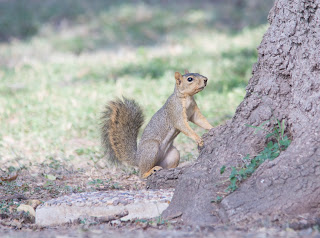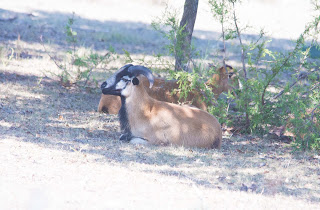Translate
Monday, October 28, 2019
Post-Rain Adventures still Continue with One Shorebird
Pine Siskin atop Bradford Pear
Yellow-rumped Warbler in Northern Catalpa
102619
0822-0929/48-50 F/clear/NW-7/87-86% RH/29.80-29.83 Hg and falling
After two solid days of rain, it was certainly necessary to get out for a while to look for birds, as I knew they would be out there. On the water we had both Pied-billed and Horned Grebes, the American Coot, Ring-billed Gulls, Ruddy Ducks, and a few Double-crested Cormorants with most of them heading south.
Songbirds comprised large numbers of Yellow-rumped Warblers, a half dozen Eastern Bluebirds, a few Pine Siskins with a couple of fall plumaged American Goldfinches, several Chipping Sparrows, and last but not least a Savannah and a White-crowned Sparrow. The Carolina Chickadees were there as a welcoming committee, but no unusuals were there...yet.
Greater Yellowlegs
102719
0815-0934/50-55 F/clear/SE-9/83-8-% RH/29.72 Hg and steady to 29.81 Hg and rising
Today there were both the Bewick's and Carolina Wrens, American Goldfinch, Western Meadowlark,
38 Yellow-rumped Warblers with most of them in the air, my first Dark-eyed Junco of the season staring me down in a tree, and the Greater Yellowlegs that I saw from Heron Cove. It was so far away, I thought that I had a yellowlegs or Solitary Sandpiper, so I had to go see for myself what was among the ten Killdeer.
Sunday, October 27, 2019
Friday, October 25, 2019
Boomer Migration Prior to Rains
Yellow-rumped Warbler, View 1
American Coots
Yellow-rumped Warbler, View 2
102219
0750-0853/45-47 F (wind chill 41)/clear/W-5/54% RH/30.06-30.09 Hg and rising
Just prior to this two day rain that began very early Wednesday October 23, birds were flying in an erratic manner and preparing by eating as much as they could.
There were a dozen or more migrant Killdeer between Shorebird Jetty and the most southwest jetty. I got the actual count when a man was walking his dog and drove them into the air and they went onto the secondary location. There were some Killdeer there, a smaller amount, but I was unable to get an exact count prior to the incident. There were at least six, but I used the dozen figure.
Since this was actually a minor seasonal cooldown, there were also a few ducks upon the water, which included eighteen Gadwall, a few Northern Shovelers (juveniles), and eight American Coots.
The coots didn't even notice me at Heron Cove, and just came nearer when the above shot was taken.
As many know, Ken Kaufman wrote a book on pishing, and gave many examples on the included CD, but I have developed many of my own calls over the years. One that I came upon was actually learned from a Palm Warbler that I once encountered at Boomer Lake. When the Palm Warbler moved out of my view, I used it to call it back last fall.
Several birds were in sycamores, western soapberry and even within the Bradford pear trees on the west side of The Cove. I'm being very conservative when I say that there were thirty-five Myrtle Yellow-rumped Warblers in the area, along with the Ruby-crowned Kinglet, Carolina Chickadee, Eastern Bluebird, American Pipit, Chipping Sparrow, and Belted Kingfisher. Of course, the pipit will never be located in a tree, yet it had been clearly observed in the lowland nearby.
The warblers, kinglet, sparrow, and kingfisher all responded nicely to my own pish, and I could have shown many more photos of the warblers. The kinglet also availed itself, but was on the move, so out of the several shots that I obtained, none of them were worthy to be posted here. The chippie also hung in the brambles, but writer managed to get a lot of good looks for an extended period of time and just might have come up with other birds.
Then the rain hit and my birding adventures were curtailed. Perhaps tomorrow...
For the Palm Warbler Sighting:
https://debhirt.blogspot.com/2018/10/oklahoma-migratory-species-profile-palm.html
Sunday, October 20, 2019
Hardcore Birding: The Birders--Northern Colombia
Colombia has the most bird species in the world. There are 2,000 species with more than 70 endemics or restricted to that area only. It also includes over 200 migrants with at least 160 hummingbirds, and the numbers increase on a yearly basis.
More animals shown are the Streak-capped Spinetail, White-lored Warbler, Blackburnian Warbler (neotropical migrant), Specious Tyrannulet, White-lined Tanager, Santa Marta Brushfinch, Tennessee Warbler (neotropical migrant), Black-and-white Warbler (neotropical migrant), Golden-olive Woodpecker, Baltimore Oriole (neotropical migrant), Burrowing Owl (neotropical migrant), Neotropic Cormorant (neotropical migrant), Scarlet-fronted Parakeet, Andean Pygmy-Owl, Golden-headed Quetzal, Santa Marta Antpitta, Masked Trogon, Groove-billed Toucanet, Whooping Motmot, Black-cheeked Mountain-Tanager, Russet-throated Puffbird, Black Skimmer (neotropical migrant), Royal Tern (neotropical migrant), Laughing Gull (neotropical migrant), Pearl Kite, Scaled Dove, Black-crested Antshrike, Double-striped Thick-knee, Slender-billed Tyrannulet, Tropical Mockingbird, Brown-crested Flycatcher (neotropical migrant), Great Kiskadee (neotropical migrant), Vermilion Flycatcher (neotropical migrant), Brown Pelican (neotropical migrant), Great Egret (neotropical migrant), Snowy Egret (neotropical migrant), Scarlet Ibis, White Ibis (neotropical migrant), Roseate Spoonbill (neotropical migrant), Least Grebe (neotropical migrant), Tricolored Heron (neotropical migrant), Black-crowned, Night-Heron (neotropical migrant), American Flamingo, Orinican Saltator, Gray Kingbird, Glaucous Tanager, Buffy Hummingbird, Trinidad Euphonia, American Kestrel (neotropical migrant), Crested Bobwhite, Ferruginous Pygmy-Owl (neotropical migrant), Ruby-topaz Hummingbird, Bicolored Wren, Blue-capped Tanager, Golden Grosbeak, Band-tailed Guan, White-tipped Quetzal, Santa Marta Bush-tyrant, Yellow-crowned Redstart, Blue-naped Chlorophonia, Flammulated Treehunter, Hermit Wood-Wren, Santa Marta Screech-Owl, Crowned Woodnymph, Lesser Violetear, Amethyst-throated Sunangel, Pale-bellied Hermit, Brown Violetear, Tyrean Metaltail, Sparkling, Violetear, Black-chested Jay, Thick-billed Euphonia, Summer Tanager (neotropical migrant), Red-crowned Woodpecker, Golden-faced Tyrannulet, Swallow Tanager, Crested Orendopola, Crimson-backed Tanager, Buff-throated Saltator, Bat Falcon, Pale-breasted Thrush, Collared Aracari, Sharp-shinned Hawk (neotropical migrant), Slaty Brushfinch, Southern Emerald-Toucanet, Lacrimose Mountain-Tanager, Black-chested Buzzard-Eagle, Andean Guan, Barred Becard, Buff-breasted Mountain-Tanager, Straight-billed Woodcreeper, Cottontop Tamarin and White-fronted Tamarin Monkeys.
102019 SNP Edition, Life at Boomer Lake
Sunday, October 13, 2019
Birding On a Shoestring: Texas' Edwards Plateau and Area
Red Squirrel
Egyptian Geese Juveniles
Ditto, View 2
Muscovy Duck
100619
Johnson Park in Marble Falls, TX
Marble Falls has always been a good stopover point for an assortment of wildlife. Having first shot an award winning Great Horned owlet photo more than five years ago, this area has always had a soft spot in writer's heart. Suffering extensive flooding damage last year, this locale has seen great revitalization, and is unquestionably a birding hotspot in Burnet County. Egyptian Geese moved into this area this year and we experienced the young ones this spring when we came through the area enroute to Del Rio. You'll observe assorted raptors like the Red-tailed and Red-shouldered Hawks, ducks and waterbirds, both Turkey and Black Vultures, and many birds breed here, too.
This is a small sample of the wildlife available this fall, but there is much more. Experience the hospitality and friendliness of the area. You'll be glad that you shared the Marble Falls Experience.
Domestic Sheep
100719
Fredericksburg, Texas
This beautiful domestic sheep was in the vicinity of Enchanted Rock, and we came upon him as well as a few exotics while traveling to the park shortly after sunup. Many migrants were observed there including wrens, warblers, Blue Grosbeak, both Vultures, rock squirrel, and more. The greatest number of birds are near the creek as one gets ready to climb Enchanted Rock. The best birding trail is just to the right of the Rock Trail.
Bewick's Wren in Song
Bewick's Wren, View 2
Hutton's Vireo
100818
Hutton's Vireo was a target species on this trip, as were a few other birds that we were unable to
locate on this Audubon Certified Golf Course and residential location. Much of the habitat found here is natural and pesticide use was only on an as-needed basis.
Queen
Canyon Wren
Underwing Moth
100919
Private Exotic Species Ranch
Writer photographed many of the East Indian and African species, but managed to miss a few. One Plains Zebra was actually just a few feet from the car. My camera had a long range lens on it, rendering that photo impossible to make. However, my hunt was with the above photo of the oryx. about a mile or a little better on foot. By the time that they stopped, they were just as curious about me as I was of them.
Watusi (Exotic Cattle)
Aoudad (Exotics)
Oryx (Exotics)
Plains Zebra (Exotics)
Ostrich (Exotic)
Sitka (Exotic)
Red Deer (Exotic Elk)
Texas White-tailed Deer
Ribbon Snake
101019
These photos were taken in the heart of the Edwards Plateau or Texas Hill Country. Many private ranches were toured, which explains the exotic animals. At one ranch, we even sampled smoked meat from the axis deer. Some of the other ranches were also working ranches for white-tailed deer and Northern Bobwhite (quail), both native species.
There are many schools of thought on the exotic animals, some of which have managed to become escapees in the area. Most of the exotic ranchers are continuously going through their ranches to check fencing to ascertain the safety of the native species of the Edwards Plateau, a respected Texas ecosystem.
These are regions that also provide important habitat to the well being of the recently delisted Black-capped Vireo, as well as the Golden-cheeked Warbler, a Federally protected species.
Woodhouse's Scrub-Jay
101119
Pedernales River State Park in Johnson City, Texas (Blanco County)
This was one of the most exciting birds of the trip and is the first scrub-jay that I have ever photographed.
For additional information on Johnson Park:
https://debhirt.blogspot.com/2019/04/birding-on-shoestring-texas-hill.html
https://debhirt.blogspot.com/2014/04/johnson-park-in-marble-falls-texas.html
Monday, October 7, 2019
Subscribe to:
Posts (Atom)


























